- Clone
- 10E5 (See other available formats)
- Regulatory Status
- RUO
- Other Names
- DNAM-1, PTA1 (platelet and T cell activation antigen 1), TLISA1, LFA-1 associated Molecule PTA-1
- Isotype
- Rat IgG2b, κ
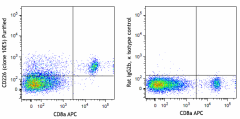
-

C57BL/6 mouse splenocytes were stained with CD8a APC and purified CD226 (clone 10E5, left) or purified rat IgG2b, κ isotype control (right), followed by anti-rat IgG2b FITC. -

C57BL/6 mouse frozen spleen section was fixed with 4% paraformaldehyde (PFA) for 10 minutes and blocked with 5% FBS for 30 minutes at room temperature. Then the section was stained with 10 µg/ml CD226 (clone 10E5) purified and CD3ε (clone 500A2) Alexa Fluor® 594 (green) overnight at 4°C, followed by 2.5 µg/ml of goat anti rat IgG (clone Poly4054) Alexa Fluor® 647 (red) for 2 hours at room temperature. Nuclei were counterstained with DAPI (blue). The image was captured by 10X objective.
| Cat # | Size | Price | Quantity Check Availability | ||
|---|---|---|---|---|---|
| 128822 | 500 µg | $370.00 | |||
CD226 (DNAM-1) is constitutively expressed on native CD8+ cells and on CD4+ T cells, macrophages and NK cells.This antibody (10E5) was reported to bind about 40% of inactivated CD4+ cells and binds only to differentiated Th1 cells, but not to Th2 or Th0 cells.It is also reported to suppress antigen-specific T cell expansion and EAE (experimental allergic encephalitis) mediated by Th1 cells.
Product Details
- Verified Reactivity
- Mouse
- Antibody Type
- Monoclonal
- Host Species
- Rat
- Immunogen
- Th1 polarized T cell clones
- Formulation
- Phosphate-buffered solution, pH 7.2, containing 0.09% sodium azide.
- Preparation
- The antibody was purified by affinity chromatography.
- Concentration
- 0.5 mg/ml
- Storage & Handling
- The antibody solution should be stored undiluted between 2°C and 8°C.
- Application
-
FC - Quality tested
IHC-F - Verified - Recommended Usage
-
Each lot of this antibody is quality control tested by immunofluorescent staining with flow cytometric analysis. For flow cytometric staining, the suggested use of this reagent is ≤1.0 µg per million cells in 100 µl volume. For immunohistochemistry on frozen tissue, a concentration range of 5.0 - 10.0 µg/ml is suggested. It is recommended that the reagent be titrated for optimal performance for each application.
-
Application References
(PubMed link indicates BioLegend citation) -
- Dardalhon V, et al. 2005. J. Immunol. 175:1558
- Huang Z, et al. 2011. J Immunol. 186:3421. PubMed
- Product Citations
-
- RRID
-
AB_2728146 (BioLegend Cat. No. 128822)
Antigen Details
- Structure
- 65 kd glycoprotein of a member of Ig-superfamily containing 2 immunologlobulin-like domains.
- Distribution
-
Expressed on majority of CD4+ and CD8+ T cells, NK cells, monocytes/macrophages and a subset of B cells and thymocytes. Reported to be specifically expressed on the surface of Th1 cells, but downregulated in Th2 cells.
- Function
- Mediates cellular adhesion, involved in LFA-1 costimulatory signal for T cell differentiation and proliferation
- Ligand/Receptor
- CD112 and CD155
- Cell Type
- B cells, Macrophages, Monocytes, NK cells, T cells, Th1
- Biology Area
- Immunology
- Molecular Family
- Adhesion Molecules, CD Molecules
- Antigen References
-
1.Tahara Hanaoka S, et al. 2006. Blood 107:1491
2. Shibuya K, et al. 2003. J. Exp. Med. 198:1829 - Gene ID
- 225825 View all products for this Gene ID
- UniProt
- View information about CD226 on UniProt.org
Other Formats
View All CD226 Reagents Request Custom Conjugation| Description | Clone | Applications |
|---|---|---|
| FITC anti-mouse CD226 (DNAM-1) | 10E5 | FC |
| PE anti-mouse CD226 (DNAM-1) | 10E5 | FC |
| Alexa Fluor® 647 anti-mouse CD226 (DNAM-1) | 10E5 | FC |
| APC anti-mouse CD226 (DNAM-1) | 10E5 | FC |
| PE/Cyanine7 anti-mouse CD226 (DNAM-1) | 10E5 | FC |
| PerCP/Cyanine5.5 anti-mouse CD226 (DNAM-1) | 10E5 | FC |
| APC/Fire™ 750 anti-mouse CD226 (DNAM-1) | 10E5 | FC |
| PE/Dazzle™ 594 anti-mouse CD226 (DNAM-1) | 10E5 | FC |
| Biotin anti-mouse CD226 (DNAM-1) | 10E5 | FC |
| Purified anti-mouse CD226 (DNAM-1) | 10E5 | FC,IHC-F,IP |
| TotalSeq™-A0852 anti-mouse CD226 (DNAM-1) | 10E5 | PG |
| TotalSeq™-C0852 anti-mouse CD226 (DNAM-1) Antibody | 10E5 | PG |
Compare Data Across All Formats
This data display is provided for general comparisons between formats.
Your actual data may vary due to variations in samples, target cells, instruments and their settings, staining conditions, and other factors.
If you need assistance with selecting the best format contact our expert technical support team.
-
FITC anti-mouse CD226 (DNAM-1)

BALB/c splenocytes were stained with CD8 (clone 53-6.7) APC ... -
PE anti-mouse CD226 (DNAM-1)
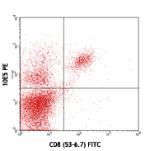
C57BL/6 splenocytes stained with CD8 (53-6.7) FITC and 10E5 ... -
Alexa Fluor® 647 anti-mouse CD226 (DNAM-1)

C57BL/6 splenocytes stained with CD8 (53-6.7) FITC and 10E5 ... -
APC anti-mouse CD226 (DNAM-1)
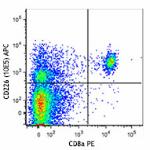
C57BL/6 mouse splenocytes were stained with CD8a PE and CD22... 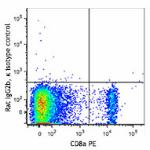
-
PE/Cyanine7 anti-mouse CD226 (DNAM-1)

C57BL/6 mouse splenocytes were stained with CD8a FITC and CD... -
PerCP/Cyanine5.5 anti-mouse CD226 (DNAM-1)

C57/B6 mouse splenocytes were stained with CD8a FITC and CD2... -
APC/Fire™ 750 anti-mouse CD226 (DNAM-1)
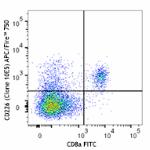
C57BL/6 mouse splenocytes were stained with CD8a FITC and CD... 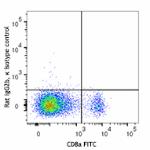
-
PE/Dazzle™ 594 anti-mouse CD226 (DNAM-1)
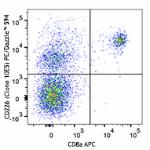
C57BL/6 mouse splenocytes were stained with CD8a APC and CD2... 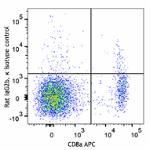
-
Biotin anti-mouse CD226 (DNAM-1)

C57BL/6 mouse splenocytes were stained with CD8a APC and bio... 
-
Purified anti-mouse CD226 (DNAM-1)

C57BL/6 mouse splenocytes were stained with CD8a APC and pur... 
C57BL/6 mouse frozen spleen section was fixed with 4% parafo... -
TotalSeq™-A0852 anti-mouse CD226 (DNAM-1)
-
TotalSeq™-C0852 anti-mouse CD226 (DNAM-1) Antibody
